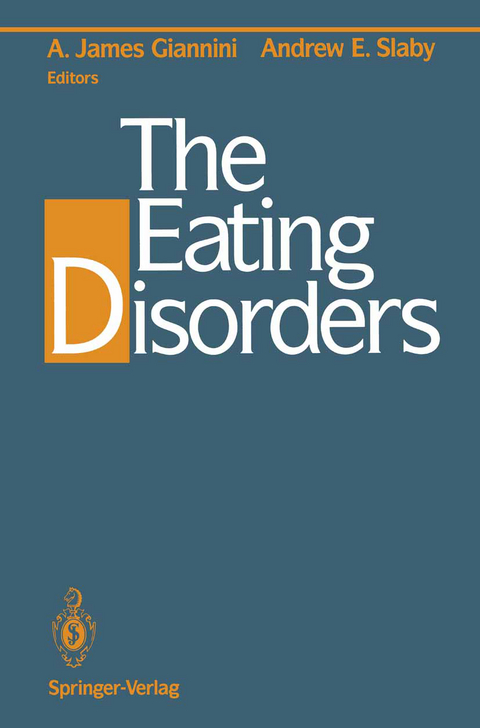
The Eating Disorders
Springer-Verlag New York Inc.
978-0-387-94002-1 (ISBN)
- Titel z.Zt. nicht lieferbar
- Versandkostenfrei
- Auch auf Rechnung
- Artikel merken
1. History of Anorexia Nervosa.- Early Observations.- Chlorosis.- Early Treatment.- Anorexia in Victorian Times.- Gull and Laseque.- The Biological Era.- The Psychoanalytic Era.- Anorexia Today.- Summary.- References.- 2. A History of Bulimia.- References.- 3. The History of Obesity.- References.- 4. The Presentation of Obesity.- What is Obesity?.- Summary: How the Patient Presents.- References.- 5. The Biological Basis of Bulimia.- Brain Regulation of Appetite and Feeding.- Bulimia and Affective Disorders.- Drug Trials I—Suggested by Theorized Relationship of Bulimia to Affective Disorders.- Drug Trials II—Suggested by Theorized Relationship of Bulimia to Seizure Disorder.- Drug Trials III—Suggested by Theorized Neurotransmitter Control of Appetite.- Conclusion.- References.- 6. Biological Factors in Obesity.- Overview.- Genetics.- Perinatal Factors.- Neuroanatomy and Neurochemistry of Eating.- Nutritional Factors.- Metabolic Factors.- Biological Models of Obesity.- References.- 7. Clinical Laboratory Aspects of Eating Disorders.- General Laboratory and Medical Considerations.- Basal Luteinizing, Follicle Stimulating Hormone, and Gonadotropin Releasing Factor (GnRF) Challenge Studies.- Basal Thyroid, Prolactin, Growth Hormone, and TRH Challenge Testing.- Dexamethasone Suppression Testing.- Drugs of Abuse, Diuretics, and Laxative Testing.- Additional Considerations.- Conclusion.- References.- 8. Neuropsychiatric Approach to the Eating Disorder Patient.- Medical Mimics.- Neuropsychiatric Investigation.- Clinical Example.- References.- 9. Anorexia in the Elderly.- References.- 10. Depression and Eating Disorders.- Frequency of Depression.- Family Studies.- Antidepressant Treatment.- Polysomnography.- Positron Emission Tomography.- Neuroendocrinology.-Neurochemistry.- Summary.- References.- 11. Sexual Abuse and Its Relationship to Eating Disorders.- References.- 12. Males with Eating Disorders.- Anorexia Nervosa.- Bulimia Nervosa.- Conclusion.- References.- 13. The Medical Care of the Patient with an Eating Disorder.- Endocrine and Metabolic Complications.- Cardiac Complications.- Gastrointestinal Complications.- References.- 14. Pediatric Management of Eating Disorders.- Anorexia Nervosa and Bulimia.- Specific Organ System Involvement.- Obesity.- Summary.- References.- 15. The B.A.S.H. Approach.- Program Structure.- The “Significant Other”.- Religion.- Evaluation.- Conclusion.- References.- 16. The Hospital Treatment of Eating Disorders.- Indications for Hospitalization.- Treatment Interventions.- Treatment Planning.- Conclusion.- References.- 17. The Treatment of Obesity.- Defining Obesity.- Weight Loss.- The Diet.- Behavior Therapy.- Weight Loss Programs and Products.- Conclusion.- References.- 18. Eating Disorders and Drug and Alcohol Dependency.- Definitions and General Characteristics of the Disorders.- Prevalence of the Disorders.- The Co-occurrence of Alcohol and Drug Dependence and Eating Disorders.- Familial Rates in the Disorders.- Common Interactions Between the Disorders.- Treatment.- Future Research.- References.- 19. Occupational Therapy Treatment of Anorexia Nervosa.- Occupational Behavior: A Model of Practice.- Treatment Strategies, Assessment, and Treatment Intervention.- Assessment.- Summary.- References.- 20. Occupational Therapy Treatment of Bulimia Nervosa.- Bulimia Nervosa.- A Theoretical Model in Treatment of Bulimia Nervosa: Occupational Behavior.- Summary.- References.- 21. Dietary Management of Eating Disorders.- Nutrition Assessment.- Eating Disorders.- Anorexia Nervosa.- Bulimia.-Obesity.- Summary.- References.- 22. Administration and Management of Eating Disorders Units.- Admission Criteria and Procedure.- Nutritional Assessment and Treatment.- Patient Classification.- Quality Assurance and Control.- Unit Standards.- Conclusion.- References.- 23. Literary Resources.- Birth of the Modern (Paul Johnson).- Bonfire of the Vanities (Tom Wolfe).- Bread and Chocolate (Francis Brusati).- Decameron (Giovanni Bocaccio).- Dinner at Eight (George S. Kaufman/Edna Ferber).- Dinner for Adele (Oldrich Lipsky).- English Wayfaring Life in the Middle Ages (J.J. Jessread).- Fatso (Anne Bancroft).- Georgy Girl (Silvio Narizzino).- Good Fellows (Martin Scorcese).- Le Morte D’Arthur (Sir Thomas Mallory).- Metamorphosis (Franz Kafka).- Nina’s Book (Eugene Burdick).- Pantagruel (Francois Rabelais).- Satyricon (Titus Petronius Arbiter).- Sermons (Bernard of Clairvaux).- The Physiology of Taste (Jean-Anthelme Brillat-Savarin).- Voss (Theodore White).
| Zusatzinfo | XVII, 286 p. |
|---|---|
| Verlagsort | New York, NY |
| Sprache | englisch |
| Themenwelt | Geisteswissenschaften ► Psychologie |
| Medizin / Pharmazie ► Gesundheitswesen | |
| Medizin / Pharmazie ► Medizinische Fachgebiete ► Psychosomatik | |
| Medizin / Pharmazie ► Medizinische Fachgebiete ► Psychiatrie / Psychotherapie | |
| ISBN-10 | 0-387-94002-2 / 0387940022 |
| ISBN-13 | 978-0-387-94002-1 / 9780387940021 |
| Zustand | Neuware |
| Haben Sie eine Frage zum Produkt? |
aus dem Bereich


